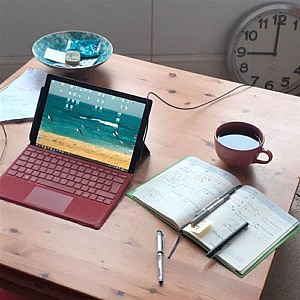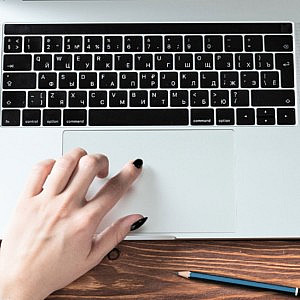Virtual organising: What is it, and how does it work?
Since the start of the pandemic, virtual organising has become more and more popular and many of our APDO members are working with their clients in this way. But what is "virtual organising" exactly, and how does it work? In this National Organising Week post, four APDO professional organisers tell us about their virtual work with their clients.Karen Eyre-White of Go Do
I help busy, overwhelmed people get back in control of their time and learn new habits to stay productive, both in their work and personal lives. At the moment I'm working with a lot of people who are working from home due to COVID-19 and struggling to focus and stay productive. We look at what's stopping them from getting things done and put in place new routines, structures and techniques which help them to get the most out of their time. This can be a lifesaver, especially for those in busy, demanding jobs, perhaps with a team working for them and often an extremely high workload. I work entirely virtually (via Zoom), and this works really well for productivity coaching. The client generally joins meetings from their normal workplace, at home or in the office, and they can share their screen when we discuss their inbox, diary, or other documents. We might also work together on screen to create a new daily or weekly schedule, or to brainstorm work objectives or priorities. The client will then go away to try out their new habits, and we'll discuss how they got on at the next session, providing both support and accountability. I love working virtually because it means I can work with clients across the UK (and the world!) and can be flexible with sessions depending on what the client needs.Tilo Flache of ClutterMeister
These days it is challenging to meet clients at their homes, and I have shifted a good portion of my business to virtual organising. In the process I have found that there are great advantages to using the virtual method. For one thing, I don't consider decluttering and organising a client's home 'just an emergency measure', but a necessary learning experience. My involvement with the client is no longer hands-on, and that makes any physical activity a little more time consuming - after all, there is one less pair of hands around to get things done! With virtual organising, the client is required to do all the work themselves, which allows us to use the tactile memory to reinforce the process and ingrain it in their body memory. This makes it much easier to remember and repeat the steps I guide them through in our sessions. The fact that I can only ever see either the work site or my client's face can make the work a little more challenging: part of my job is to keep my clients safe, both physically and mentally. Keeping an eye out for unusual reactions often requires a lot of creative camera work to stay connected with my client. The switch between work and face allows for bursts of productive work, followed by a short break with a different, more relaxed focus, before returning to the job at hand. On the plus side, separating the practical activities from the mental and emotional work can be a game-changer, especially if the client tends to be unfocused and easily distracted. I firmly believe that there are a good number of typical organising projects that actually work better virtually than they do with in-person assistance. If the job does not require a second person to be in the space, or the client is worried about the state of their home and wants to show me only the space they are working on right now, virtual assistance can work wonders.
Kate Galbally of Better Organised
I recently worked with a client who approached me about improving her time management and her productivity. She has a management role within the NHS with a very heavy workload and rapidly shifting priorities. Over the course of a few sessions, we explored how she can manage her priorities, minimise procrastination and avoid overwhelm. I introduced her to some tools and techniques that are simple to implement and easy to maintain. We also worked together on decluttering and organising her emails and her diary, so that both are manageable and work more effectively for her. At our last session, she said that working together has definitely made a difference to how she manages her time, that her emails are the most manageable that they have been in a long time and that she feels confident in the way she has planned out her time going forward. This has reduced procrastination and meant that she is able to focus better on deep work and not have to bring work home with her.Lisa Pantling of Clutter Free Living
Before the pandemic, I hadn't particularly considered working online even though many people do so, but I gave the option of working virtually to a new client whom I was going to visit at home, but had to cancel due to COVID-19. They were actually delighted with the possibility of still being able to address their difficulties with their 'stuff' and felt physically able to execute the actual decluttering and organising themselves. My client had a recent diagnosis of Asperger's and this had explained for them the reason why they struggled with sensory overload, and often felt 'frozen' in terms of working through some processes and seeing projects through to fruition. It also explained their feelings of being overwhelmed by all the decisions and options available. The next step for the client was to understand how they could manage their needs and put some systems in place that they can maintain going forward. We talked through their priorities and where they felt 'stuck'. Then we cracked on by just grabbing a pile of items piled on a dining chair. It was a total mixture of items: bills, greetings cards, work documents, old receipts, leaflets, junk mail. We addressed each category in turn, making decisions about how to deal with them in the moment and moving forward. The client took notes, including on any future actions they were going to take. Part of the success of this method involves agreeing 'rules' about how to deal with certain items, for example, greetings cards. I generally ask questions such as what value does the card hold: is it a beautiful image, was it from a special person, does it hold a special message or memory? The client felt that most of the cards they had held on to did not feel important and that they did not want or need to keep them so many could be discarded. We continued with this method and the client was able to carry out lots of work independently in between our sessions as they now had a way to rationalise their decision making.
If you are interested in finding out more about virtual organising, you can find our members who offer this service in our Find an Organiser directory.
